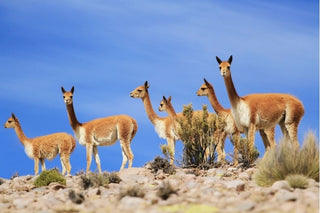The Vicuna is a magnificent and elusive creature native to the Andes, known for its incredibly soft and valuable wool. However, this species faced a significant decline in population numbers throughout history, pushing it dangerously close to extinction. Thankfully, concerted conservation efforts since the 1960s have led to the remarkable resurgence of the Vicuna population.
Once abundant throughout the Andes mountains, the Vicuna population began to decline rapidly due to several factors. Uncontrolled hunting for their valuable wool, habitat loss, and competition for resources with domesticated livestock all played a role in the decreasing numbers of Vicunas. As a result, the species was pushed to the brink of extinction by the mid-20th century.
The primary factor contributing to the decline of the Vicuna population was the unregulated hunting for their wool. Vicuna wool is highly prized for its extraordinary softness and warmth, making it a luxury material sought after by the fashion industry. However, this demand led to indiscriminate hunting, often resulting in the killing of Vicunas for their valuable fleece. Additionally, the expansion of human settlements and agricultural activities encroached upon the natural habitats of the Vicunas, further diminishing their population.
Recognizing the urgent need to protect the Vicuna from extinction, conservation organizations and governments initiated efforts in the 1960s to save the species. These efforts included the establishment of protected areas, strict regulations on hunting and trading of Vicuna wool, and the implementation of captive breeding programs. Through these measures, the Vicuna population was given a chance to recover from the brink of extinction.
The conservation efforts since the 1960s have yielded remarkable successes in reviving the Vicuna population. Strict regulations on hunting and trading of Vicuna wool have significantly reduced illegal activities and provided legal protection to the species. Furthermore, the establishment of protected areas and captive breeding programs has allowed the Vicunas to thrive in a safe environment. As a result, the population has steadily increased, demonstrating the effectiveness of these conservation initiatives.
In addition to protecting existing populations, reintroduction programs have played a crucial role in expanding the Vicuna population to its former range. By relocating Vicunas to suitable habitats where they had become locally extinct, these programs have successfully reestablished viable populations in various regions. The reintroduction of Vicunas has not only contributed to the recovery of the species but has also played a vital role in restoring ecological balance in these areas.
Vicuna wool is renowned for its exceptional quality, often considered one of the finest and most luxurious fibers in the world. The rarity and scarcity of Vicuna wool contribute to its high economic value. The increasing population of Vicunas has led to a resurgence in the production of Vicuna wool, benefiting local communities and economies in the Andean region. The sustainable harvesting of Vicuna wool has become a source of income for many communities, providing them with a livelihood while simultaneously conserving the species.
With the resurgence of the Vicuna population, there has been a growing emphasis on sustainable practices in Vicuna wool production. This includes implementing ethical shearing techniques to ensure the well-being of the animals, promoting fair trade practices, and supporting local communities involved in the industry. Sustainable practices not only ensure the long-term survival of the Vicuna population but also contribute to the preservation of traditional weaving skills and cultural heritage in the Andean region.
While the resurgence of the Vicuna population is undoubtedly a success story, there are still challenges that need to be addressed. Climate change and habitat loss continue to pose threats to the species, requiring ongoing conservation efforts. Additionally, the illegal trade of Vicuna wool remains a concern that needs to be actively combated. However, with continued commitment to conservation and sustainable practices, there is hope for the future of the Vicuna population. By raising awareness, supporting local communities, and enforcing regulations, we can ensure the long-term survival of this incredible species.
The resurgence of the Vicuna population is a testament to the power of conservation efforts and the value of sustainable practices. Through decades of dedication, strict regulations, and innovative programs, the Vicuna population has made a remarkable recovery since the 1960s. This success story not only demonstrates the resilience of the species but also serves as an inspiration for future conservation endeavors. By celebrating the resurgence of the Vicuna population, we recognize the importance of protecting our natural heritage and working towards a sustainable future for both wildlife and humans alike.








